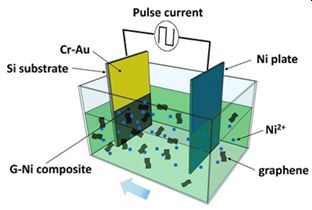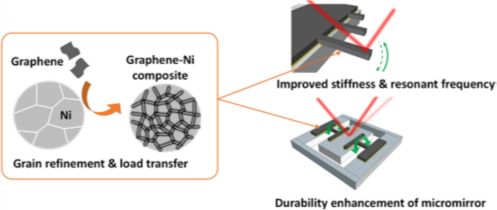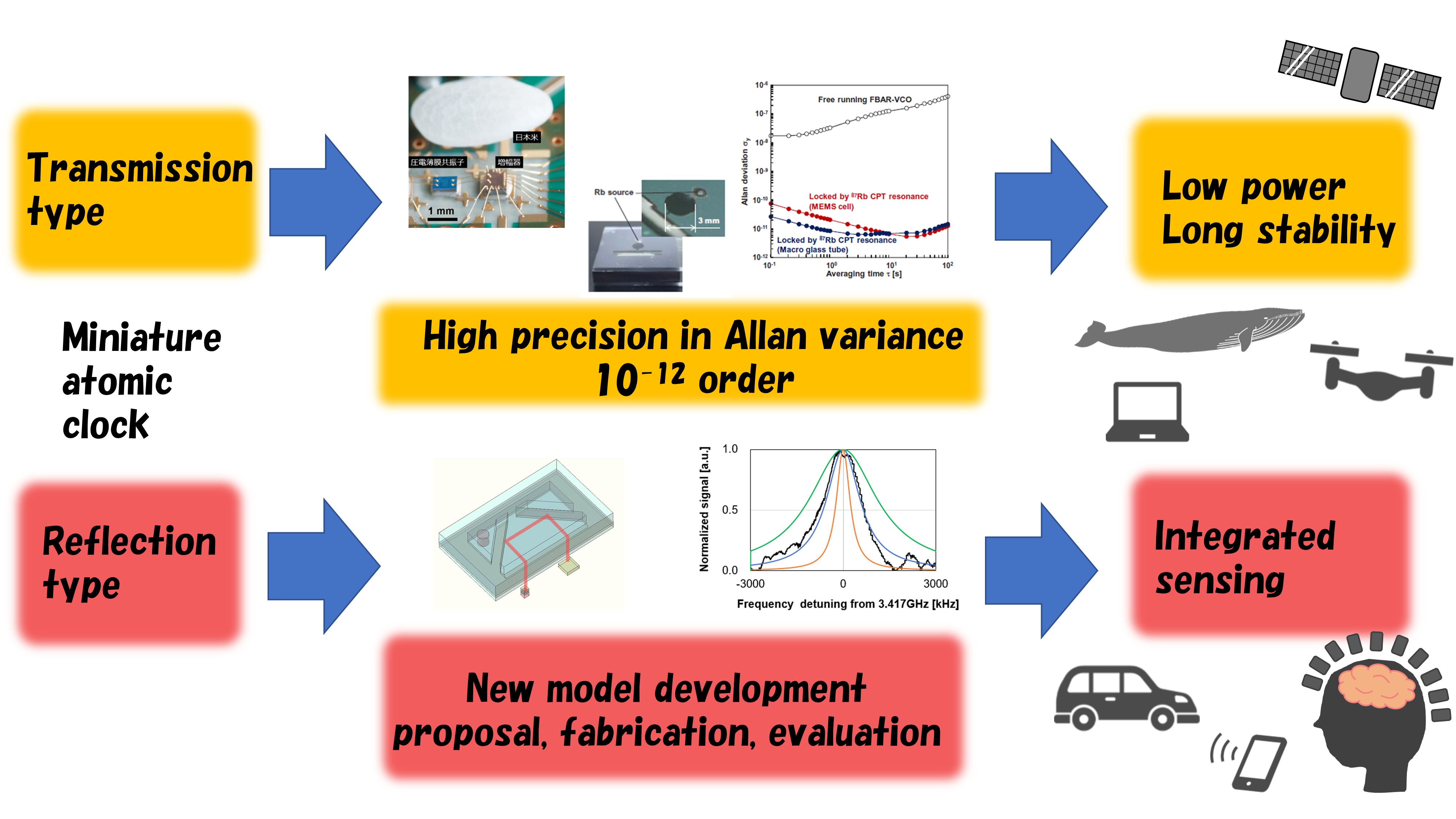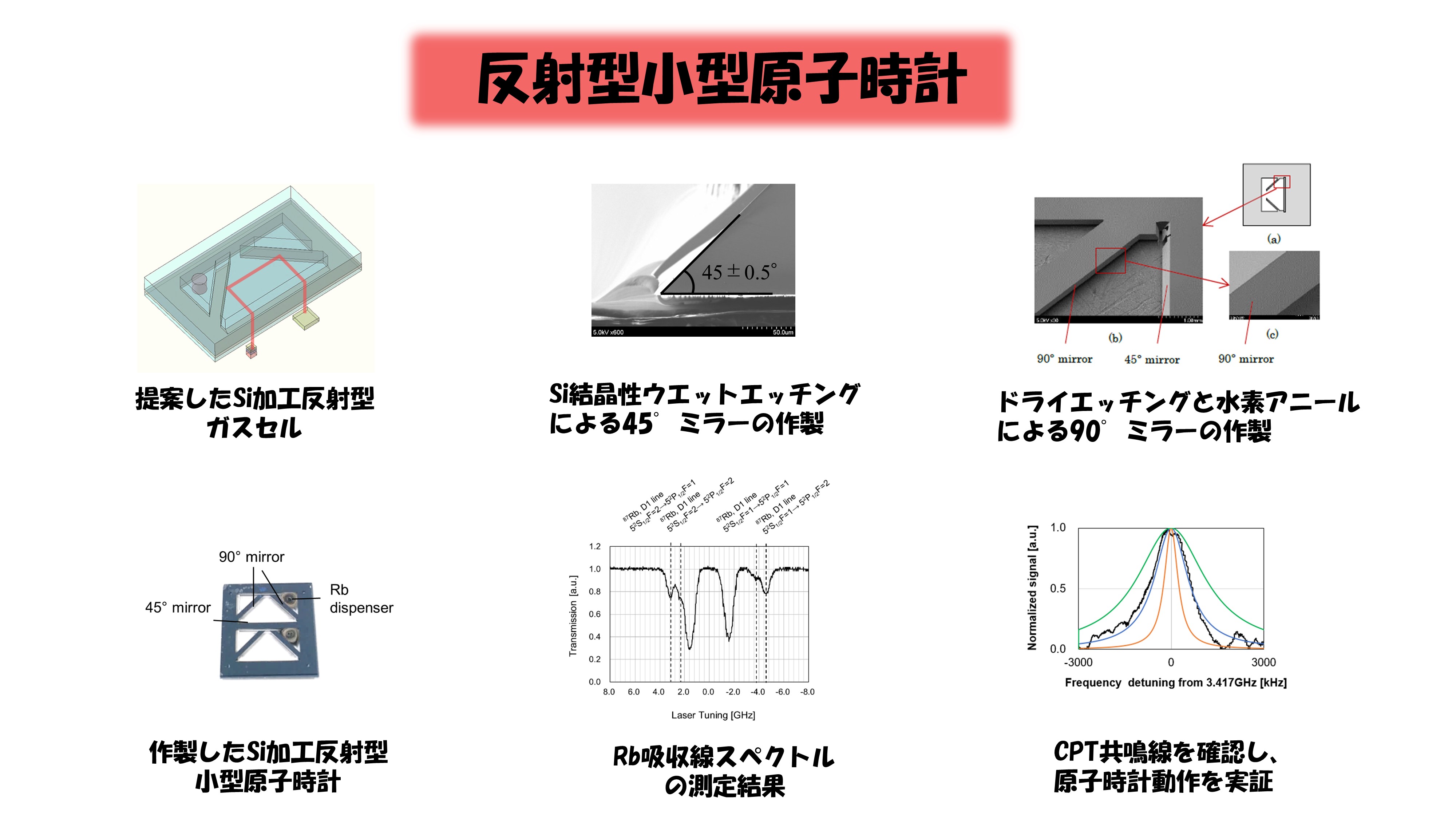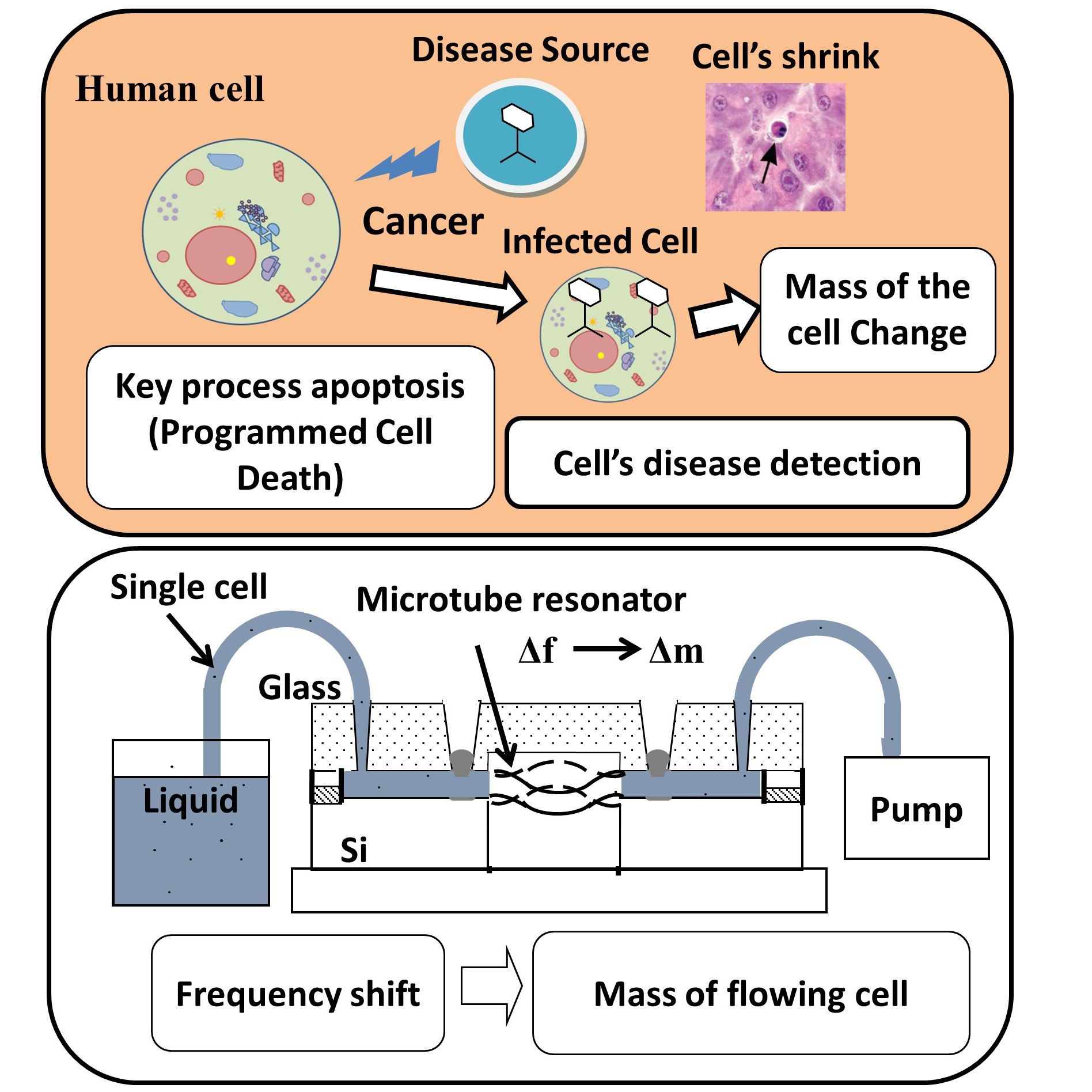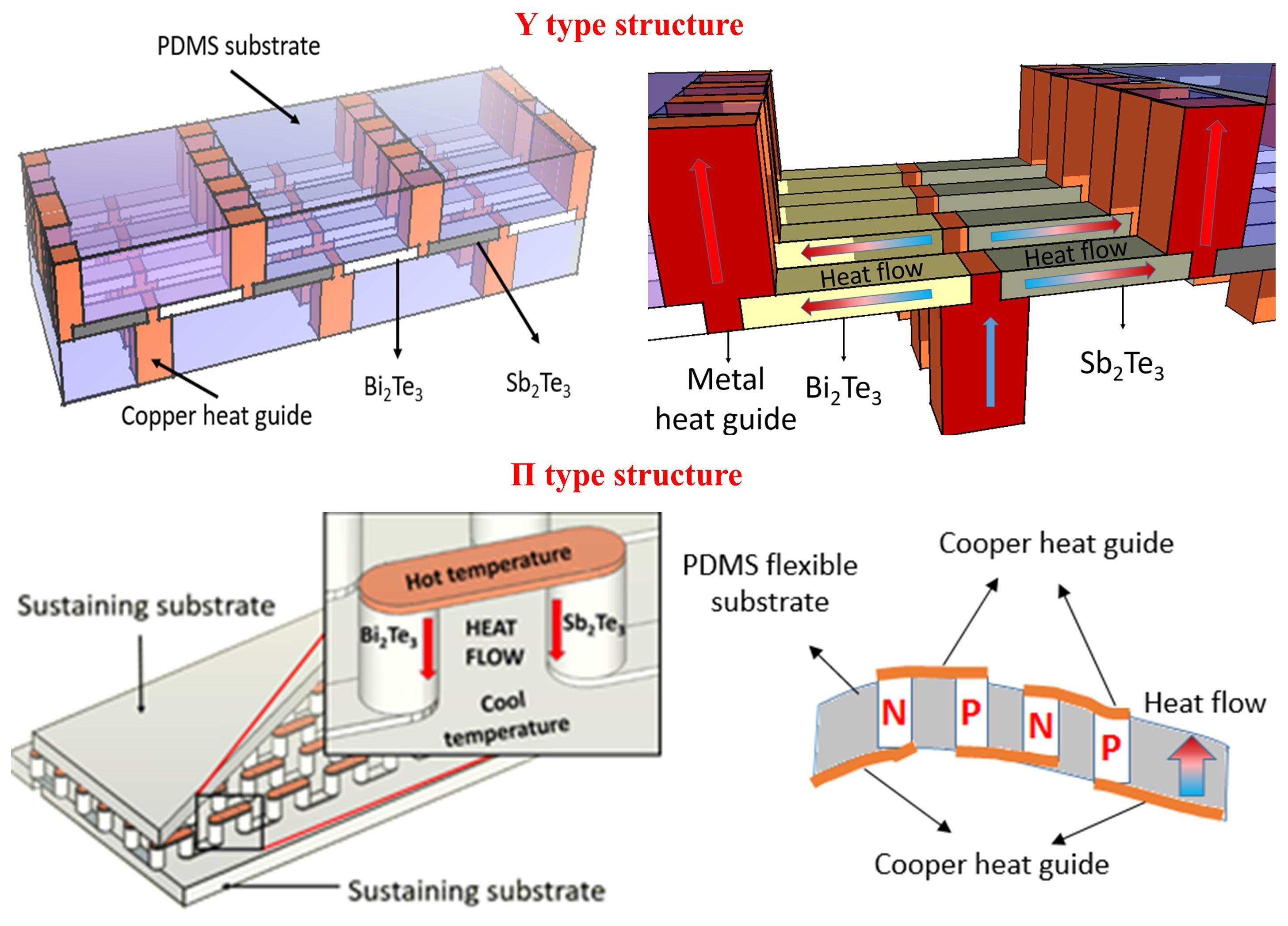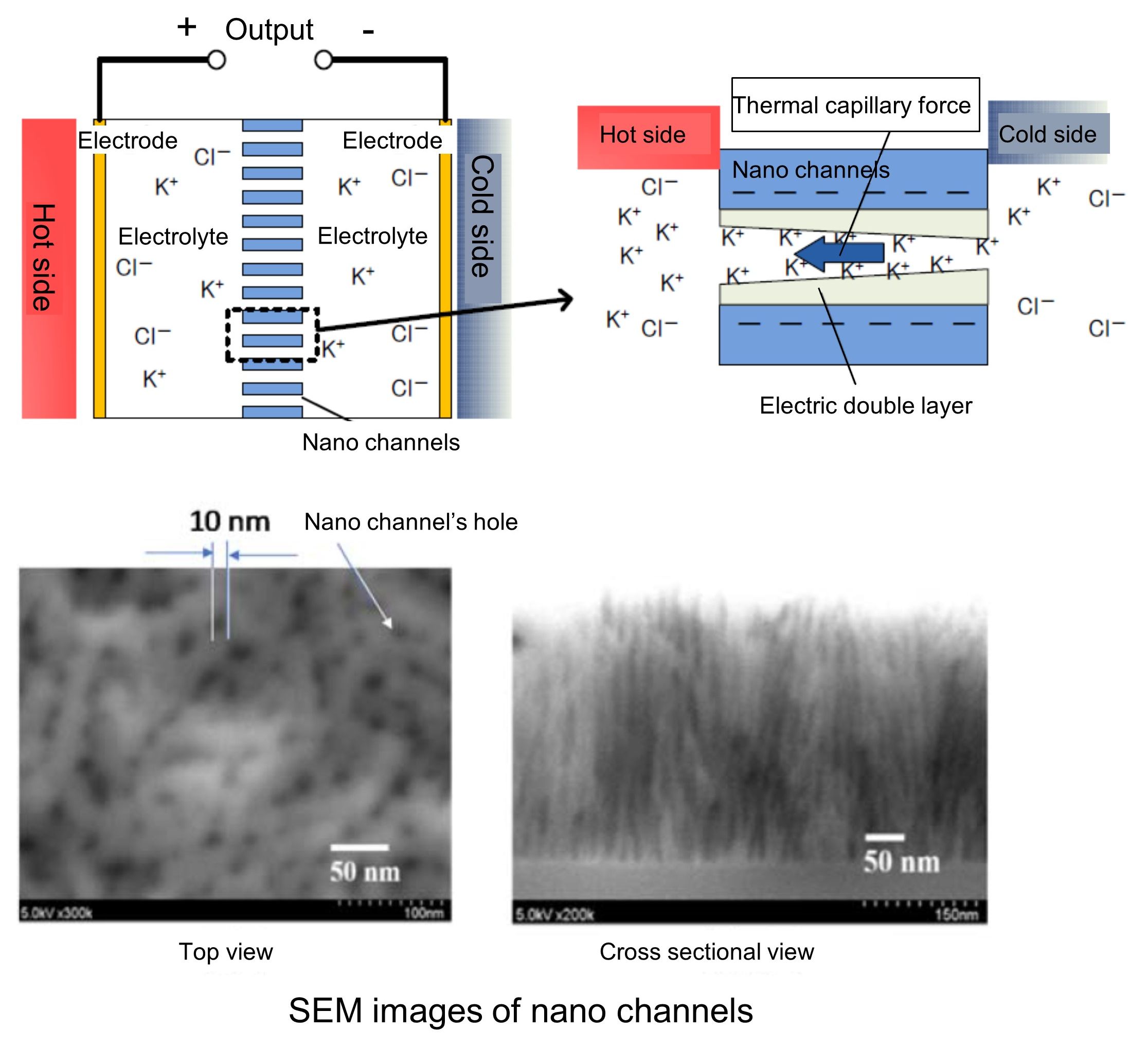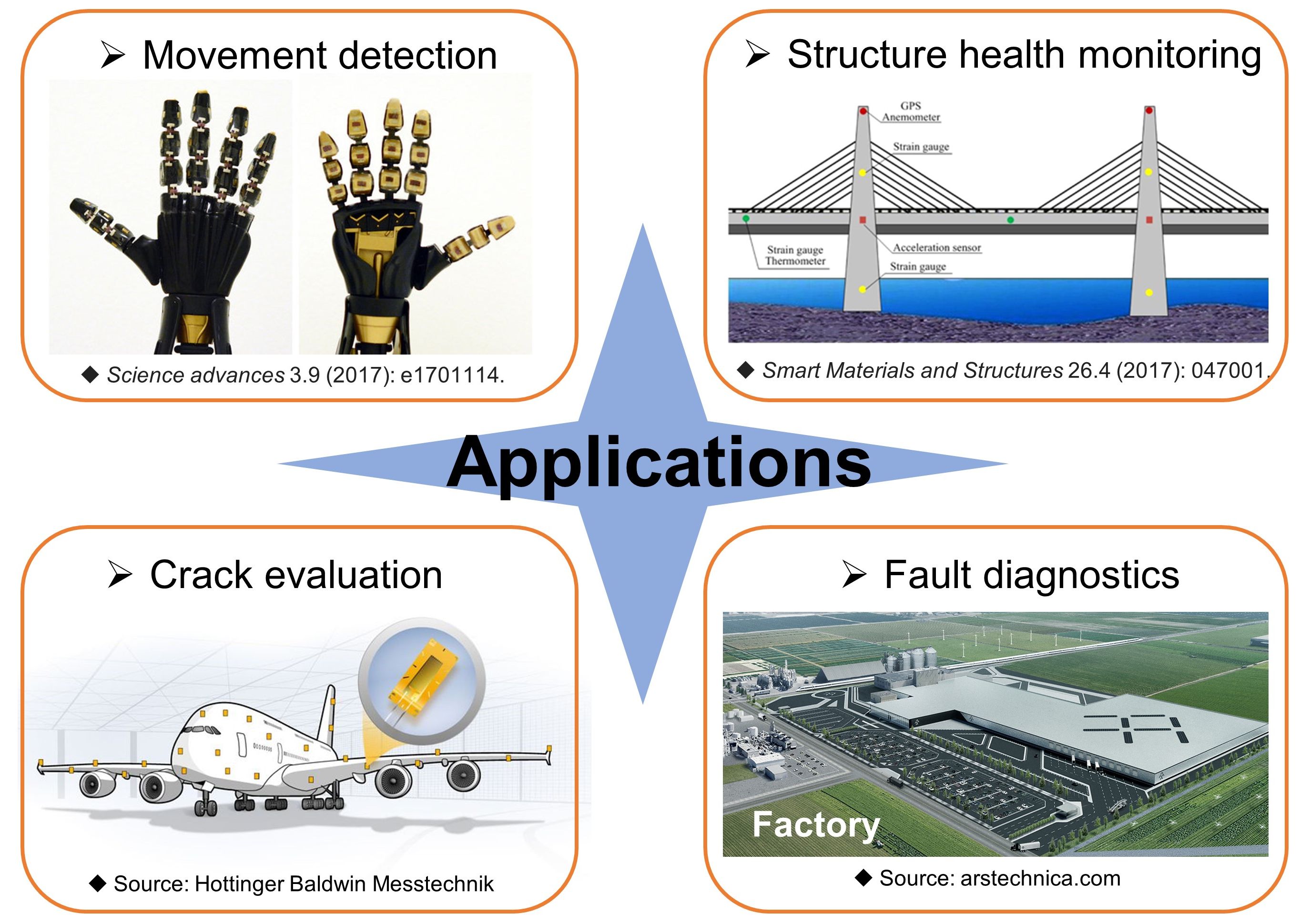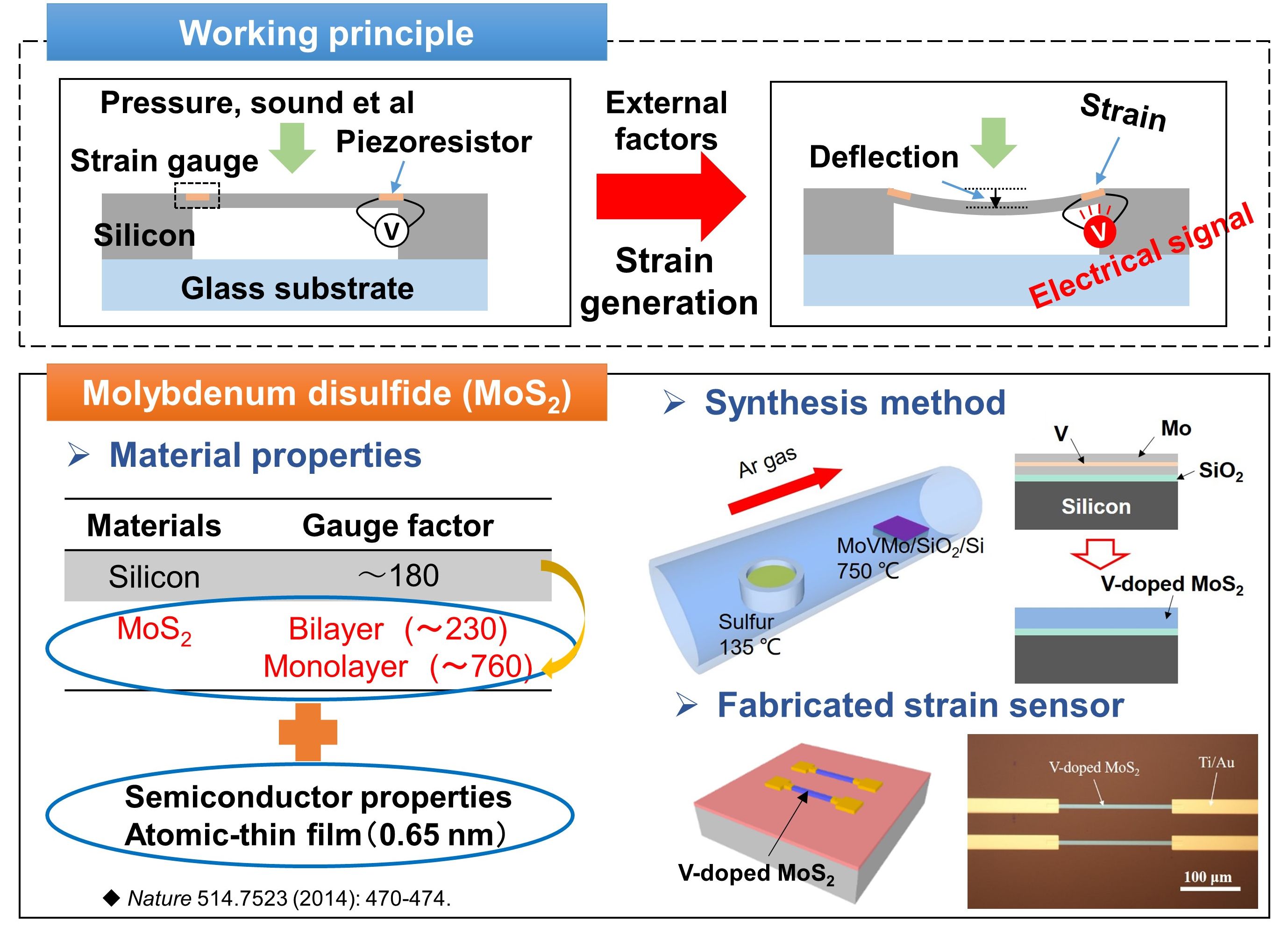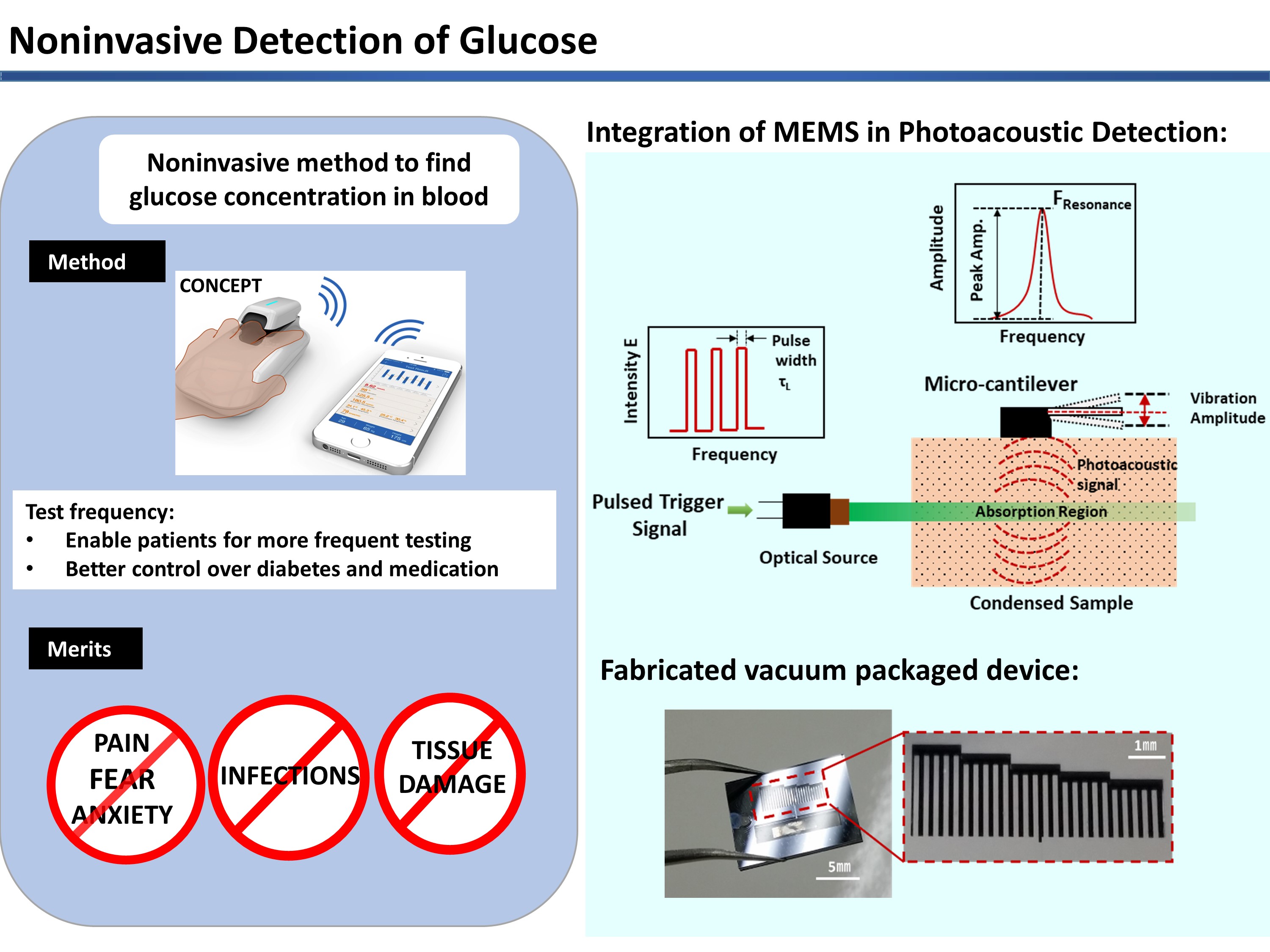Research outline
-
We have developed micro/nanomechanics and related technologies based on nanotechnology and microfabrication for information technology, bio-medicals, energy,
environments and nanoscience. In addition, ultimate sensor and sensing technologies have been developed and applied to new applications.
Recently, Internet of Things (IoT) technologies have been rapidly developed and gain its importance for world-wide issues including aging society,
environments, and energies, where micro/nanosystem and high sensitive and functional microsensors are key-technologies for IoT.
Laboratory has been studying such sensor technologies and related technologies.
Microelectromechanical systems (MEMSs) and Nanoelectromechanical systems (NEMSs) are miniaturized systems with additive values,
which are fabricated by micro/nanofabrication technologies in addition to conventional semiconductor technologies. Laboratory are working on
those technologies including micro/nanofabrication, nanomaterial technologies, novel MEMS/NEMSs and related technologies.
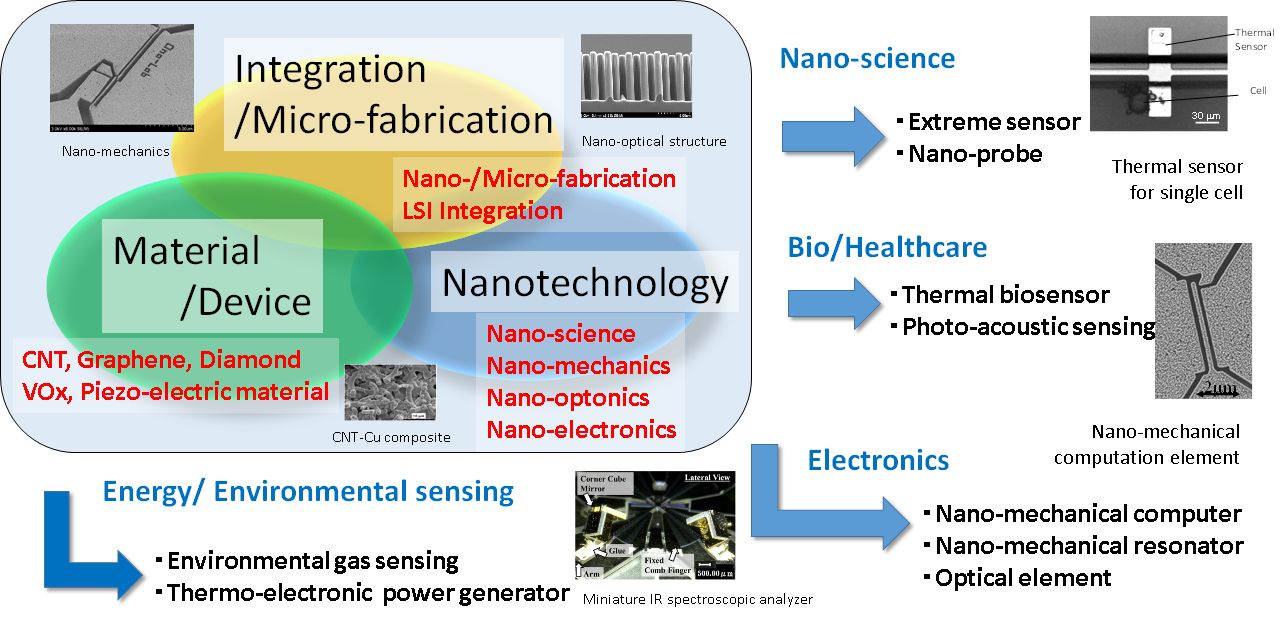
Research Outline
Topics
Research Topics (ex.)
-
Ultimate Sensing. Spintronics
- Magnetic resonance force microscopy (MRFM)
- Ultra-sensitive thermal sensors for biological samples
- Magnetostriction-based magnetic sensor of a FeGa/PZT cantilever IoT Sensors, Miniature Systems
- Thermoelectric generator for self-powered wireless sensing system
- Silicon * Polymer Thin Film Internal Stress Sensing Gas Sensor
- High precision miniature atomic clock
- Assembled micro-tube resonator for mass analysis of single cell
- Miniature Infrared Spectrometer
- Micro/Nanomechanical RF oscillators
- XYZ micro stage for Scanning Probe
- Mass analysis-Scanning probe microscope and Actuators Micro/Nano Energy Systems, Wearable
- Micro-heat sink for micro-thermoelectric generator
- Heat storage thermoelectric power generator
- Flexible thermoelectric power generators
- Nano-channeled thermoelectric power generators
- Nanomaterials and synthesis technologies
- Microthermoelectric power generator Nanomechanics, Quantum electromechanics
- Electrodeposited magnetostrictive materials and micromachining
- Nanomechanical sensors and nanomechanics Genious Materials for Micro/Nano Systems
- Thermoelectric generator from material synthesis and device fabrication to application demonstration
- Aluminum doped zinc oxide and its applications
- Piezo-electric strain sensor using MoS2
- Cabon Nanotube composite
- Graphene composites
- Supercapacitor base on graphene nanowall
- Vertically-oriented graphene electrodeposited with MnO2 for supercapacitor
- Nanocomposite thermoelectric film with nano particles Healthcare, Bio-Applications
- Photoacoustic type noninvasive glucose detector
- Healthcare microsensors and systems
- Biosensor application using VOx thermistor
- Aluminum doped zinc oxide and its applications
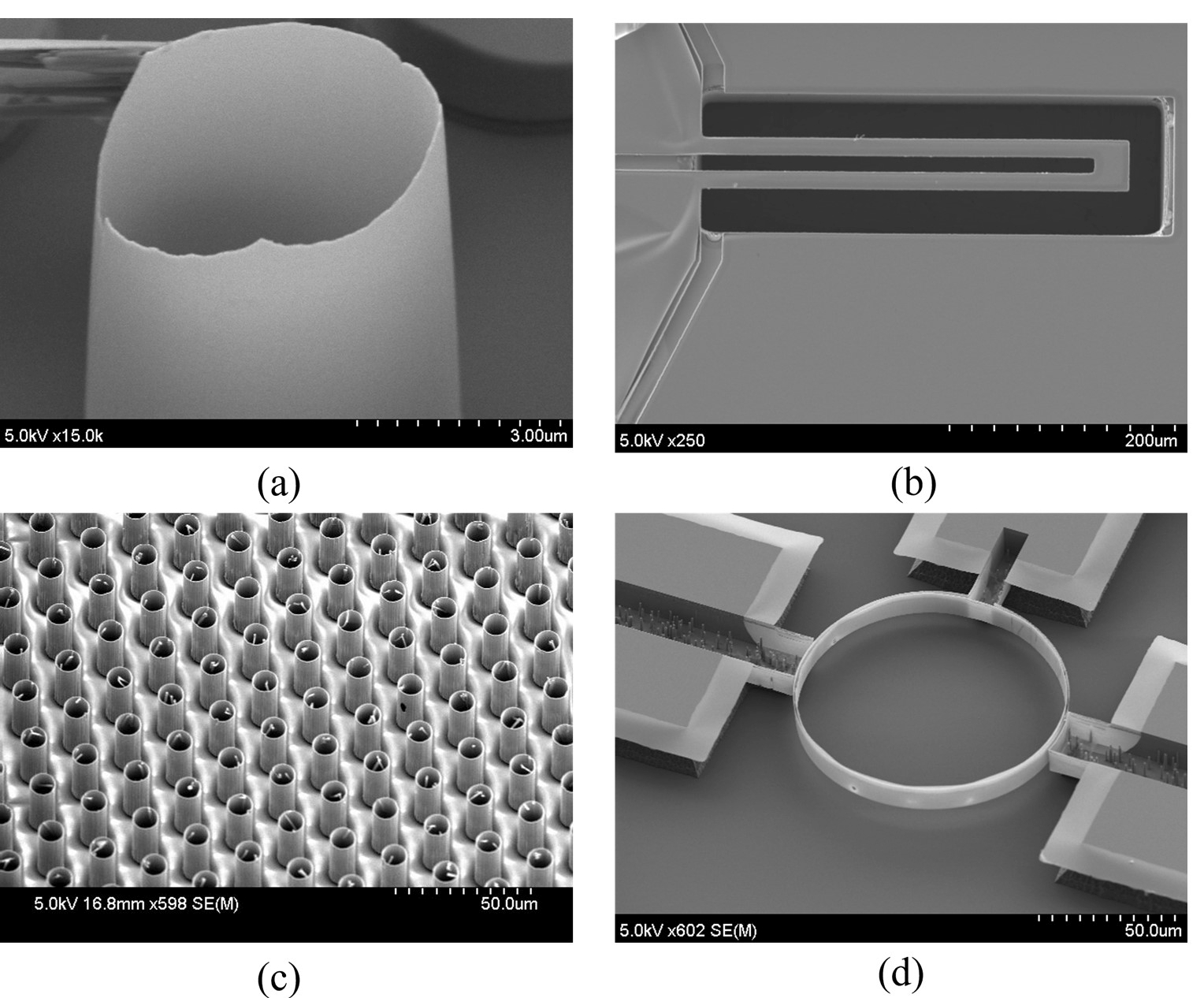
We have investigated on aluminum doped zinc oxide deposited by atomic layer deposition and its application to micro/nano devices. A novel method employed the atomic layer deposition in combination with the sacrificial silicon structures is proposed which opens the way to create the ultra-high aspect ratio structures. Four kinds of micro/nano devices have been developed successfully, including (a) Micro-hollows with nanowall structure. (b) Hollow fluidic channel. (c) Optical modulator. (d) Vertical nanomechanical capacitive resonator.
- Thermoelectric generator from material synthesis and device fabrication to application demonstration
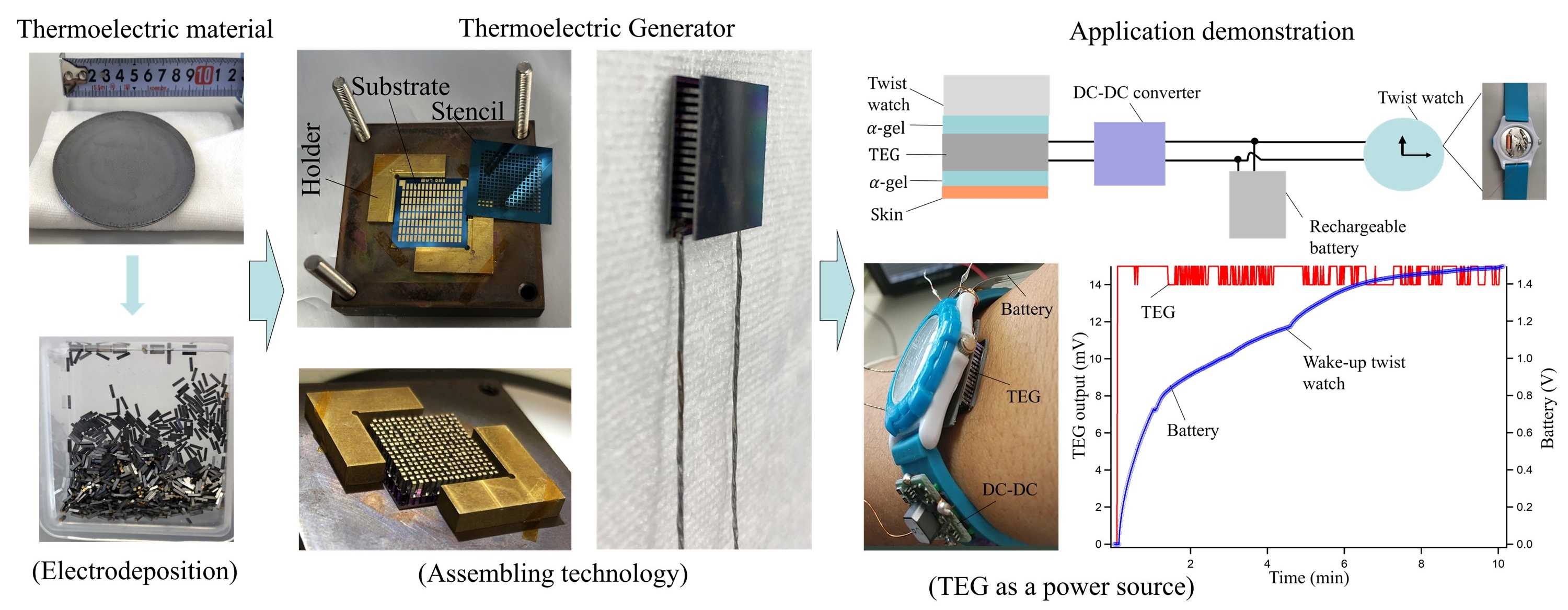
We have investigated on thermoelectric generator and its applications. Thermoelectric materials are synthesized by common three-electrode system which employed a potentiostat. The thermoelectric generator is fabricated by assembling technology. The fabricated thermoelectric generator as a power source for a calculator as well as a twist watch has been demonstrated successfully.
- Thermoelectric generator for self-powered wireless sensing system
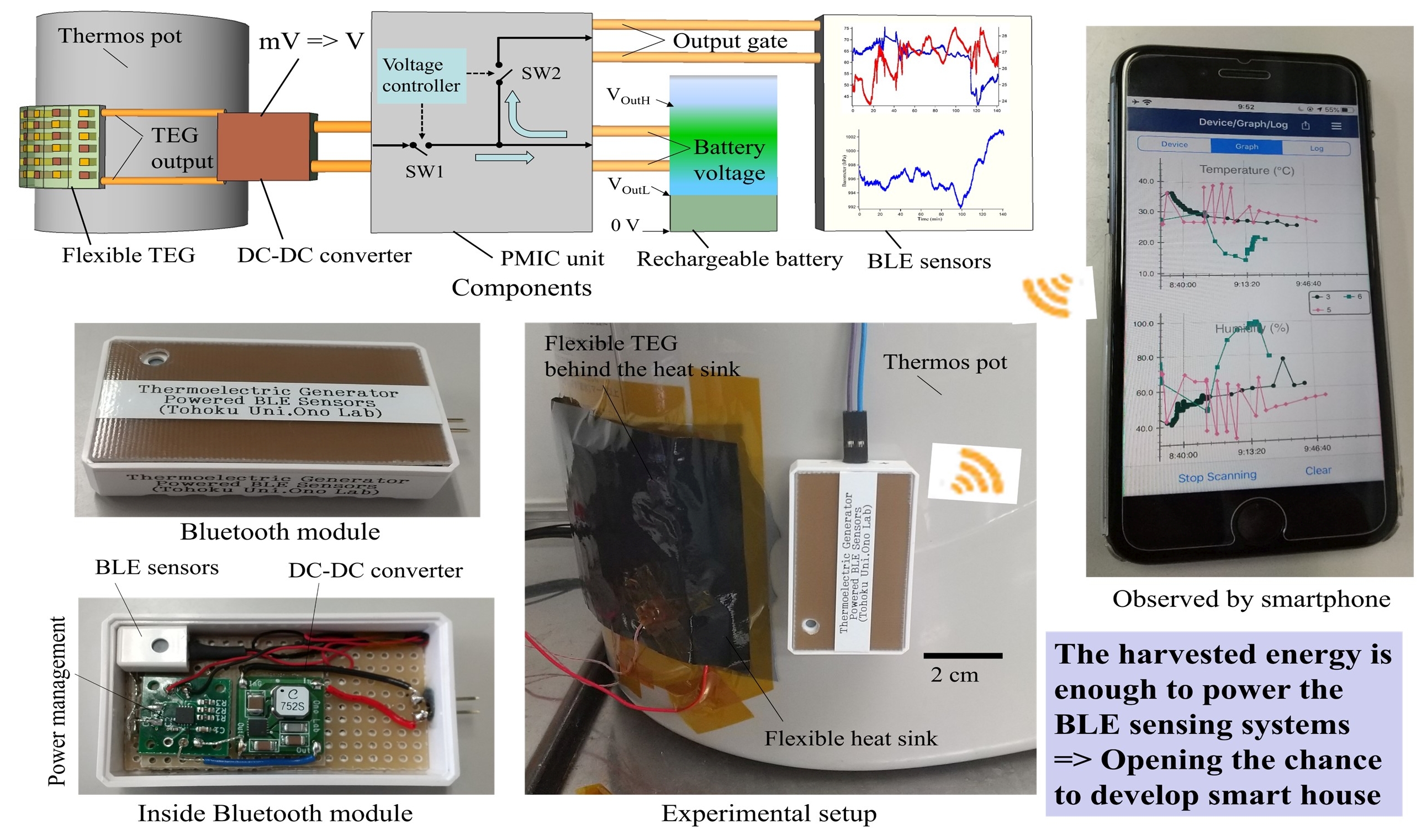
We have developed successfully the self-powered wireless sensing system driven by low thermal heat waste. The flexible thermoelectric generator has been fabricated successfully. The heat waste from the electric thermos pot converted successfully into electricity has been inspected. The harvested energy becomes usable by employing the DC-DC converter which is subsequently stored in the rechargeable battery for powering the electronic device with low-power consumption. This work brings out a new opportunity in a futuristic flexible thermoelectric generator to harvest thermal heat waste into usable electricity, especially in the fields of using wireless self-powered IoT sensing systems.
- Micro-heat sink for micro-thermoelectric generator
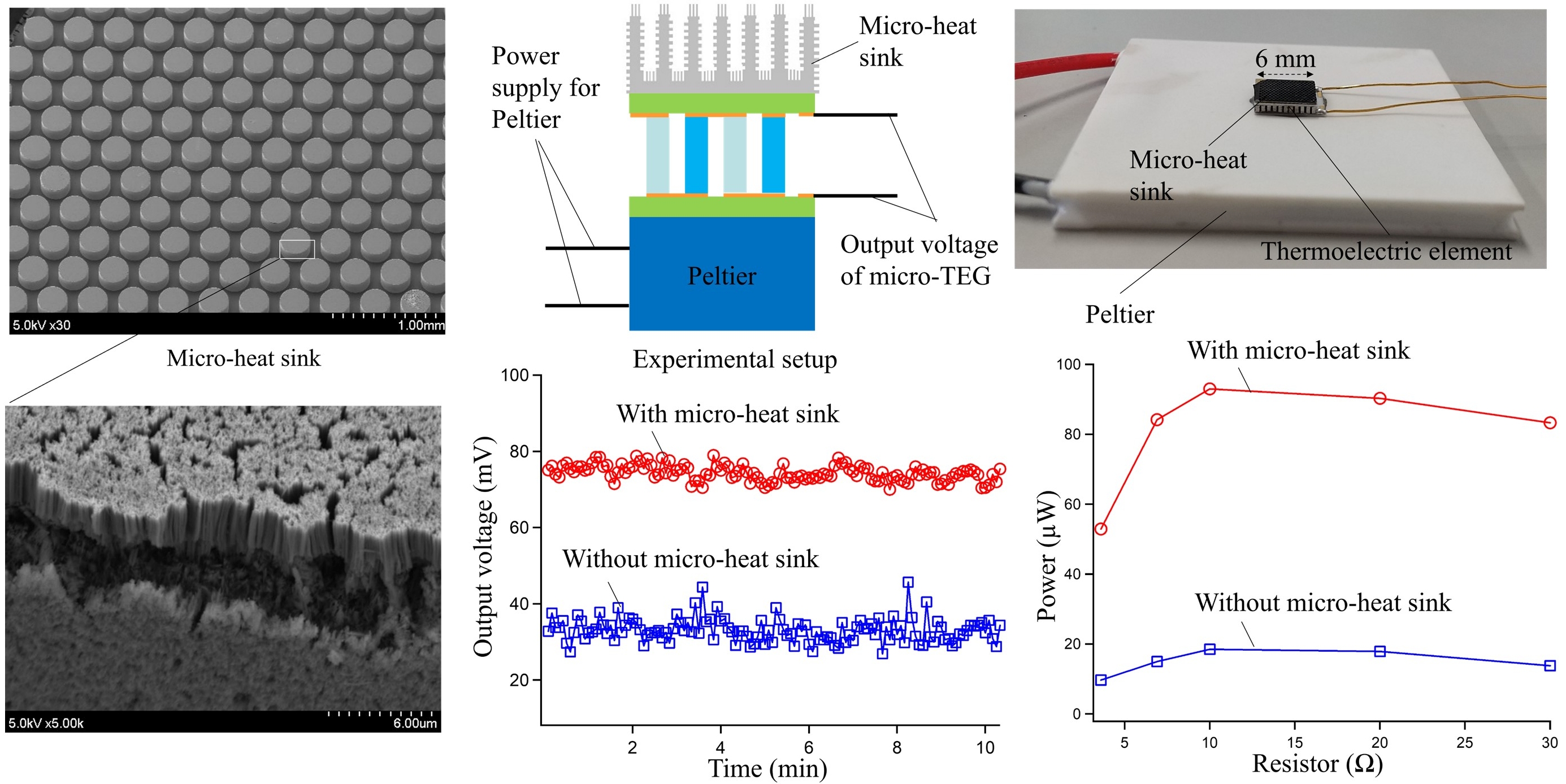
This work demonstrates the micro-heat sink based on silicon nanowires formed by metal-assisted chemical etching for heat dissipation enhancement to improve the performance of the micro-thermoelectric generator. The heat dissipation through the micro-heat sink is enhanced by increasing the surface to volume ratio. The micro-heat sink effectiveness is 8.3 times better than that of without employing the micro heat sink. The maximum output power of the micro-thermoelectric generator with and without the micro-heat sink are 93 microW and 18.5 microW, respectively, under the same evaluation conditions.
- Magnetostriction-based magnetic sensor of a FeGa/PZT cantilever
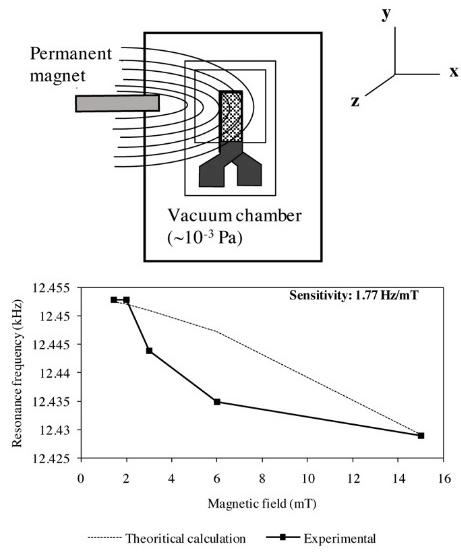
A self-detecting magnetic sensor has been developed by depositing a thin film of iron gallium (FeGa) on a lead zirconate titanate (PZT) piezoelectric material cantilever.
The FeGa/PZT cantilever is sensitive to the magnetic field direction with a sensitivity of 5.47 Hz/mT to a perpendicular static DC magnetic field.
It is also concluded that it is sensitive to magnetic forces, with a sensitivity to magnetic forces of 1.77 Hz/mT. Both sensitivities are calculated from the slope of the graph of resonant frequency shift and magnetic field divided by its resonant frequency.
The minimum detectable magnetic field for the Allan dispersion method is determined by a frequency noise of 0.02 Hz, corresponding to 3.66 ÊT.
This minimum detectable magnetic field can be improved by designing an elongated cantilever with a high Q factor using complementary materials and reducing thermal noise by structural modifications.
This magnetostriction-based magnetic sensor can be applied to direct magnetic field measurements and magnetic resonance devices such as micro-NMR and micro-ESR.
Comprehensive study of magnetostriction-based MEMS magnetic sensor of a FeGa/PZT cantilever, Sensors and Actuators A 331, (2021) 112985.
The FeGa/PZT cantilever is sensitive to the magnetic field direction with a sensitivity of 5.47 Hz/mT to a perpendicular static DC magnetic field.
It is also concluded that it is sensitive to magnetic forces, with a sensitivity to magnetic forces of 1.77 Hz/mT. Both sensitivities are calculated from the slope of the graph of resonant frequency shift and magnetic field divided by its resonant frequency.
The minimum detectable magnetic field for the Allan dispersion method is determined by a frequency noise of 0.02 Hz, corresponding to 3.66 ÊT.
This minimum detectable magnetic field can be improved by designing an elongated cantilever with a high Q factor using complementary materials and reducing thermal noise by structural modifications.
This magnetostriction-based magnetic sensor can be applied to direct magnetic field measurements and magnetic resonance devices such as micro-NMR and micro-ESR.
Comprehensive study of magnetostriction-based MEMS magnetic sensor of a FeGa/PZT cantilever, Sensors and Actuators A 331, (2021) 112985.
- Vertically-oriented graphene electrodeposited with MnO2 for supercapacitor
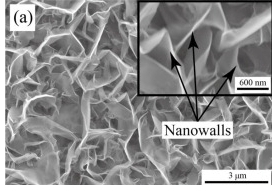
Supercapacitor electrodes, composed of vertically-oriented graphene (VG) and MnO2, are synthesized on native SiO2-passivated silicon wafers.
The VG layers with a thickness of 3 Êm are deposited directly on the substrates via plasma-enhanced chemical vapor deposition (PECVD).
The original retention of 99.29% after 5000 cycles demonstrates the excellent cycling stability, which is ascribed to the strong bonds between VG/SiO2/Si and MnO2/VG.
The promising supercapacitor electrodes in this study provide a potential for forming high-performance supercapacitor devices based on silicon wafer substrates.
Vertically-oriented graphene electrodeposited with MnO2 on native SiO2/Si for high-performance supercapacitor electrodes, Journal of Electroanalytical Chemistry 895, (2021) 115507-1-10.
The VG layers with a thickness of 3 Êm are deposited directly on the substrates via plasma-enhanced chemical vapor deposition (PECVD).
The original retention of 99.29% after 5000 cycles demonstrates the excellent cycling stability, which is ascribed to the strong bonds between VG/SiO2/Si and MnO2/VG.
The promising supercapacitor electrodes in this study provide a potential for forming high-performance supercapacitor devices based on silicon wafer substrates.
Vertically-oriented graphene electrodeposited with MnO2 on native SiO2/Si for high-performance supercapacitor electrodes, Journal of Electroanalytical Chemistry 895, (2021) 115507-1-10.
- Silicon * Polymer Thin Film Internal Stress Sensing Gas Sensor
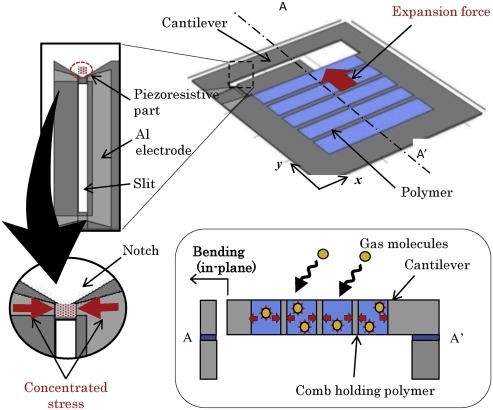
A compact silicon + polymer thin-film internal stress sensing gas sensor is developed to detect volatile organic compounds (VOCs) with low power consumption.
The sensor, which uses a piezoresistive element, can be identified by the fact that each molecule exhibits a different response rate.
A diffusion model has been developed by varying the surface concentration, allowing the sensor's response to be captured quantitatively.
Miniature piezoresistive sensor for detecting volatile organic components, Sensors and Actuators, B:Chemical 333,(2021) 129524.
The sensor, which uses a piezoresistive element, can be identified by the fact that each molecule exhibits a different response rate.
A diffusion model has been developed by varying the surface concentration, allowing the sensor's response to be captured quantitatively.
Miniature piezoresistive sensor for detecting volatile organic components, Sensors and Actuators, B:Chemical 333,(2021) 129524.
- Electrodeposited magnetostrictive materials and micromachining
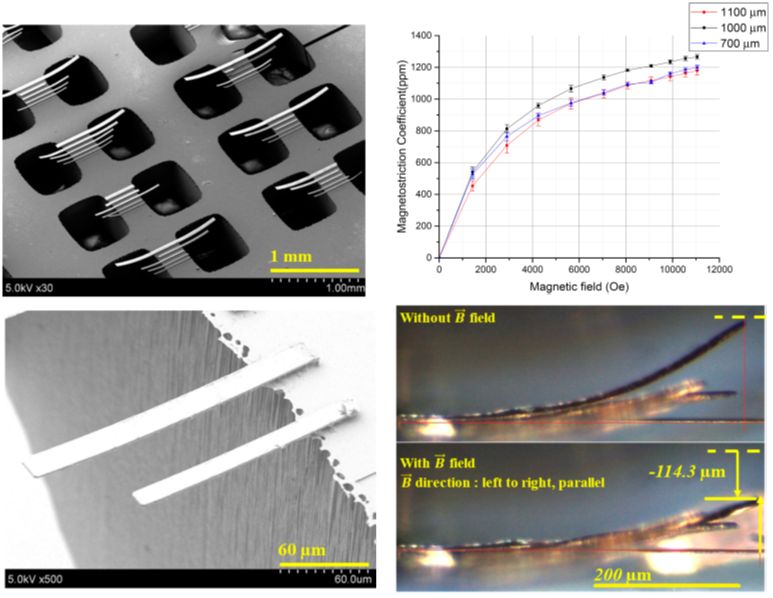
Developed an electrolytic plating process using an solution containing Tb, Dy, and Fe.
Achieves a higher energy density than the magnetostriction of solid materials.
Although it is small, it can generate a large force.
Achieves a higher energy density than the magnetostriction of solid materials.
Although it is small, it can generate a large force.
- Heat storage thermoelectric power generator
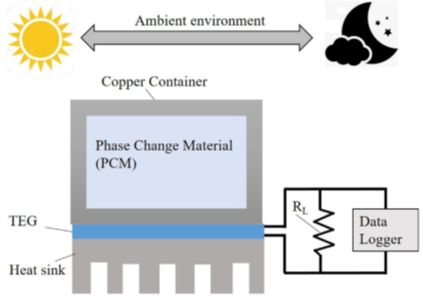
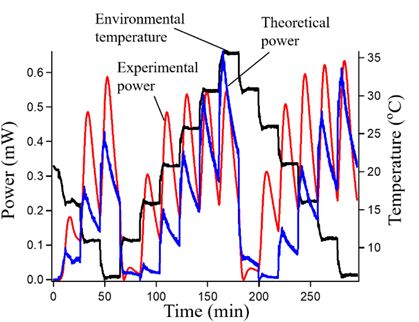
The temperature change is converted into a temperature difference by the power storage material and the heat dissipation mechanism.
- Supercapacitor base on graphene nanowall
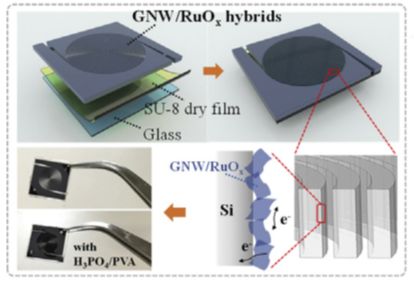
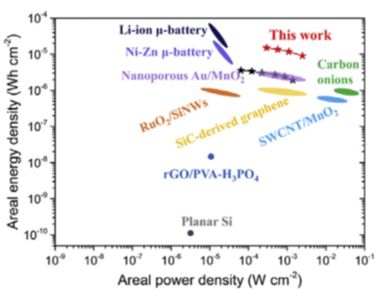
It stores the energy of the energy harvester and stores a large capacity even though it is small.
The surface area is increased by the high-density nanostructure (graphene nanostructure), and the storage capacity is improved.
- Nanocomposite thermoelectric film with nano particles
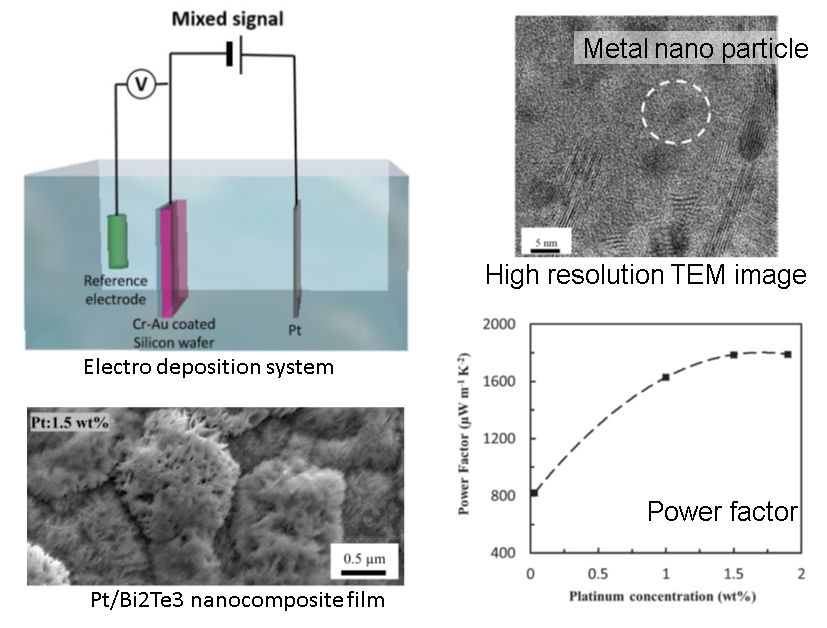
Film formation by electroplating (reduction reaction on the substrate)
Fine particles are dispersed in the liquid to form a film containing nanoparticles.
Reduces heat conduction and improves performance as a thermoelectric film.
The particles in the crystal scatter phonons that transfer heat, reducing thermal conductivity.
Fine particles are dispersed in the liquid to form a film containing nanoparticles.
Reduces heat conduction and improves performance as a thermoelectric film.
The particles in the crystal scatter phonons that transfer heat, reducing thermal conductivity.
- Biosensor application using VOx thermistor
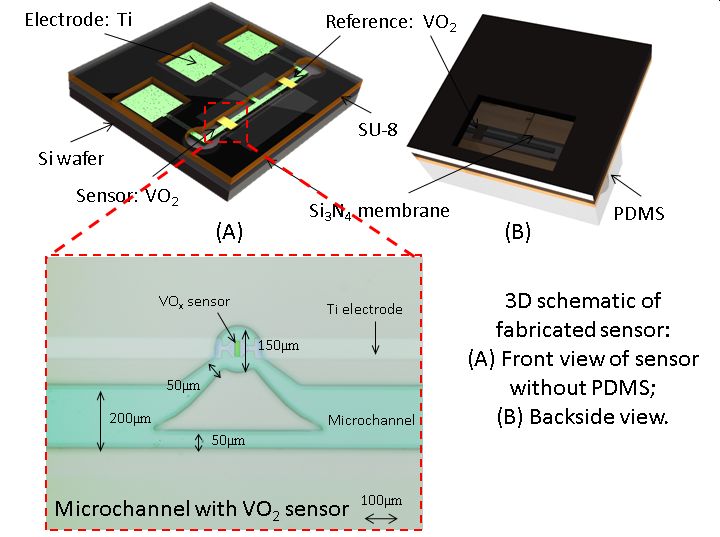
The resistance of the VO2 film changes significantly with changes in temperature.
The VO2 film was formed by sputtering or sol-gel method, and impurities were added to achieve high sensitivity.
Using the heat sensor with an enzyme fixed in the channel, we succeeded in detecting biological substances (glucose: blood glucose component), which was difficult to measure before.
The VO2 film was formed by sputtering or sol-gel method, and impurities were added to achieve high sensitivity.
Using the heat sensor with an enzyme fixed in the channel, we succeeded in detecting biological substances (glucose: blood glucose component), which was difficult to measure before.
- Ultra-sensitive thermal sensors for biological samples
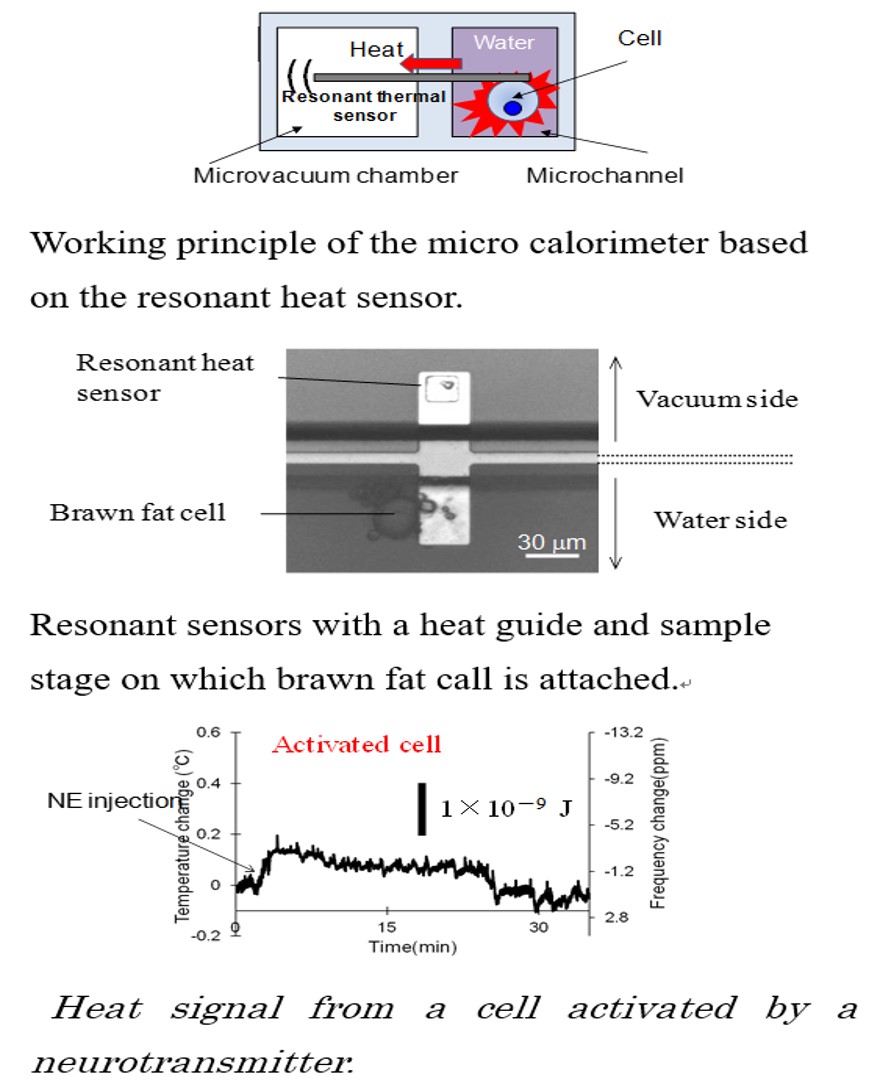
We have developed various thermal sensors for IR detection, biosensors, and hear detection of an individual biological cell.
Resonant heat sensor are developed and applied to a calorimeter for the detection of heat from a brown fat cell.
The measurement principle relies on the resonant frequency tracking of a Si resonator in temperature variation due to heat from a sample,
and heat is conducted from the sample in water to the Si resonator in vacuum via a Si heat guide, as shown in Figure 4. A heat loss to surrounding
and a dumping in water can be reduced by placing the resonant thermal sensor in vacuum. The fabricated resonant thermal sensor shows 1.6 mK of
the temperature resolution, and 6.2 pJ of the detectable minimum heat. The heat from the single cell is detected in cases without any stimulation and
with stimulation. As the results, pulsed heat production and continuous heat production are observed, respectively. The instrument contributes to future
medical and biology.
- Healthcare microsensors and systems
Miniature healthcare monitoring devices and systems have been studied to prevent lifestyle diseases and keep health
from analysis of biochemical molecules in body. The devices rely on high sensitive and functional sensors (Nanomechanical
sensors, IR spectrometers, photoacoustic sensors and thermal sensors). For example, the nanomechanical sensors utilize stress
detection of a nanomechanical structure from the displacements when molecules are adsorbed on the surface. Also in the thermal
biosensors, enthalpy change of biochemical reaction using an enzyme is detected by a high sensitive heat sensor.
- Magnetic resonance force microscopy (MRFM)
- Miniature Infrared Spectrometer
- Micro/Nanomechanical RF oscillators
- Mass analysis-Scanning probe microscope and Actuators
- Nanomechanical sensors and nanomechanics
- Nanomaterials and synthesis technologies
- Microthermoelectric power generator
- XYZ micro stage for Scanning Probe
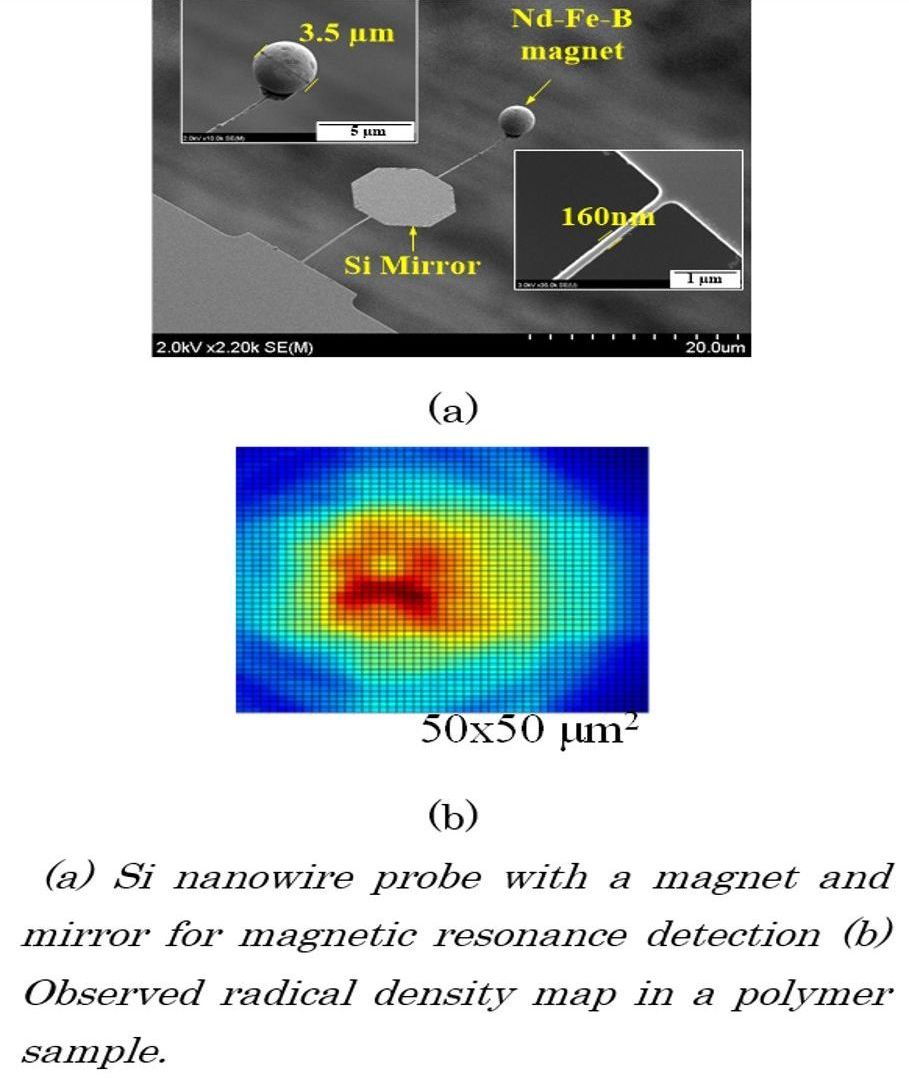
Laboratory has been working on magnetic resonance force microscopy for three dimensional imaging in a nanoscale.
A resonant sensor with a magnet is used to detect the flip of magnetic spins due to magnetic resonance. From the resonant
frequency or vibration amplitude of the resonator, magnetic force between the magnet and spins in the sample can be detected.
A Si nanowire probe with a micro magnet (Nd-Fe-B) and a Si mirror has been developed. The Si structure is fabricated by conventional microfabrication
using electron beam lithography. In order to increase the Q -factor, the fabricated Si resonator is annealed at H2/N2 atmosphere.
The vibration is measured using a fiber-optic interferometer in a vacuum chamber at room temperature.
The detectable minimum force is estimated to be around 1~ 10-17 N from thermomechanical noise signal at room temperature.
Mapping of electron resonance is demonstrated on a small particle of PVBPT (Poly-10-(4-vinylbenzyl)-10H-phenothiazine).
Also, in order to reduce the noise, mechanically-coupled resonators are investigated. Resonant signal is transferred to mechanically-coupled
another resonator by mechanical synchronization. Using frequency up-conversion based on the synchronization, the noise floor of the sensor
can be reduced.
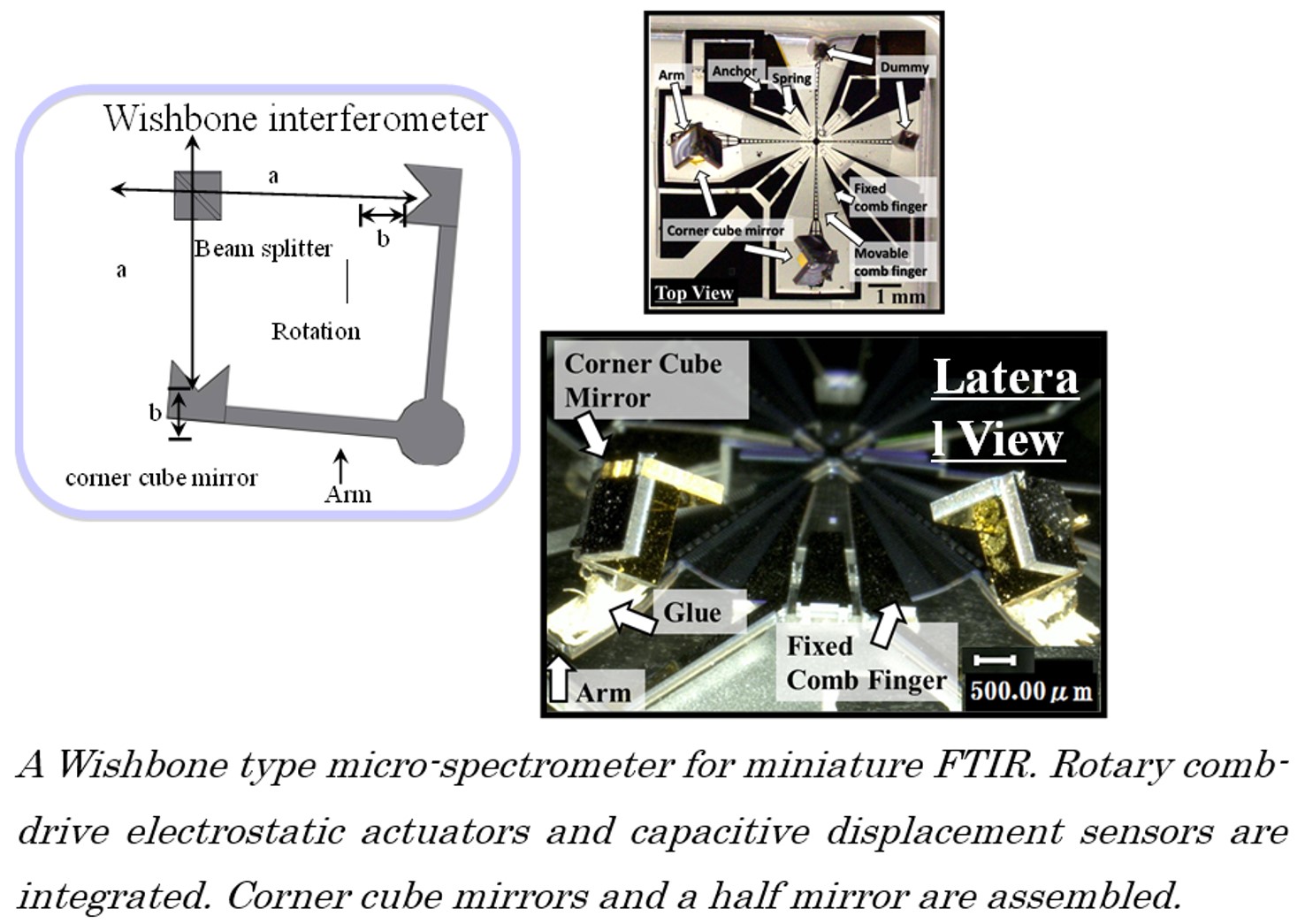
Researches on distributed infrared (IR) spectrometers have been conducted for emission gas
(including greenhouse gases) monitoring in factories and chemical plants etc. Miniature Fourier transform
IR spectrometer (FTIR) with a 8x8 mm2 spectrometer, also a dispersion type miniature spectrometer consisted
of a linear array of IR sensors have been developed. The sensor can be distributed by miniaturization and applied to environment monitoring.
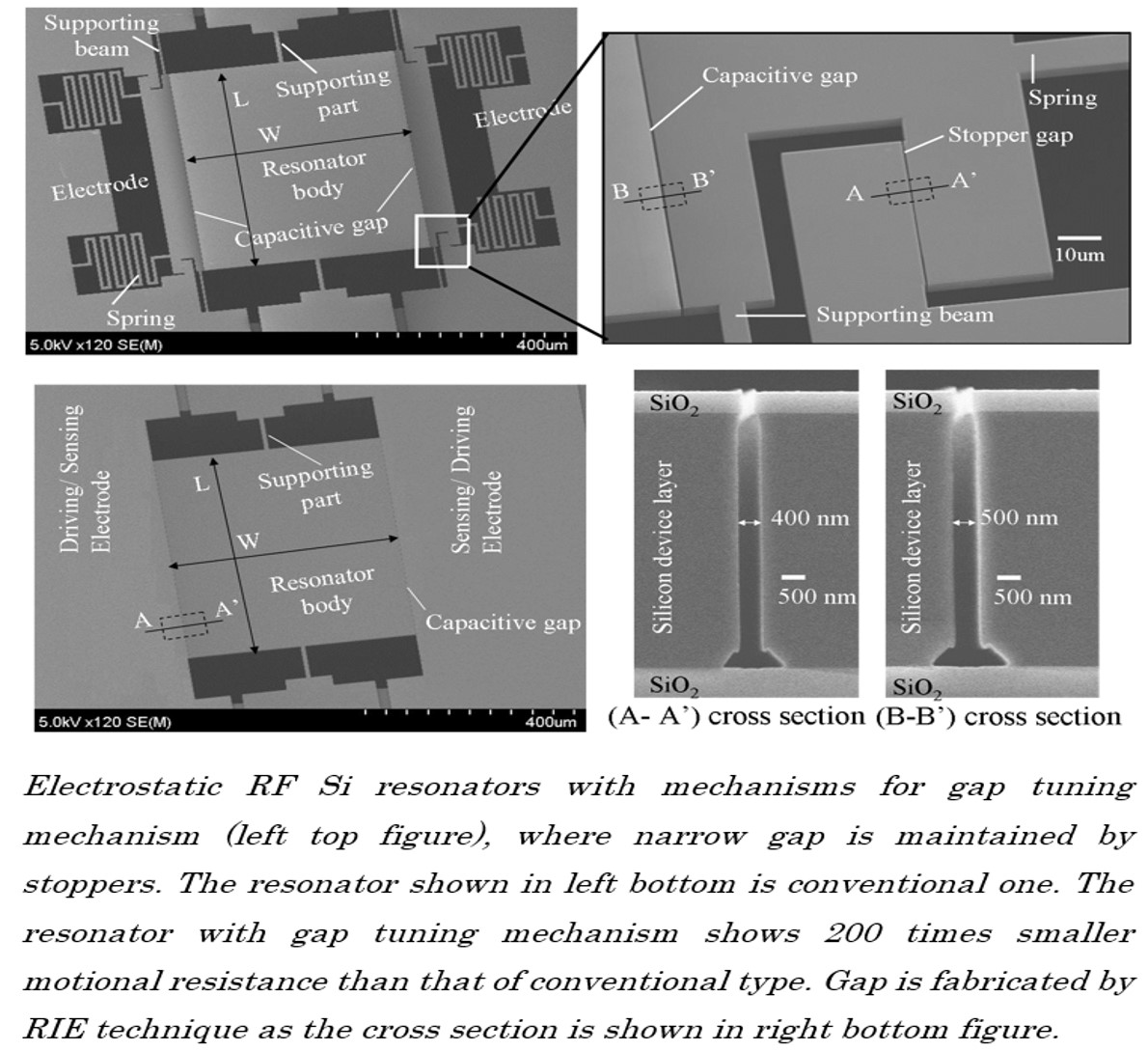
Timing devices, which create clock signal, are widely used for electronics, and generally quartz crystal oscillators
are used. For recent mobile electronics and IoT devices, much smaller RF oscillators with a high temperature stability
are required. We are working on Si micro/nanomechanical resonators and oscillators for above purpose.
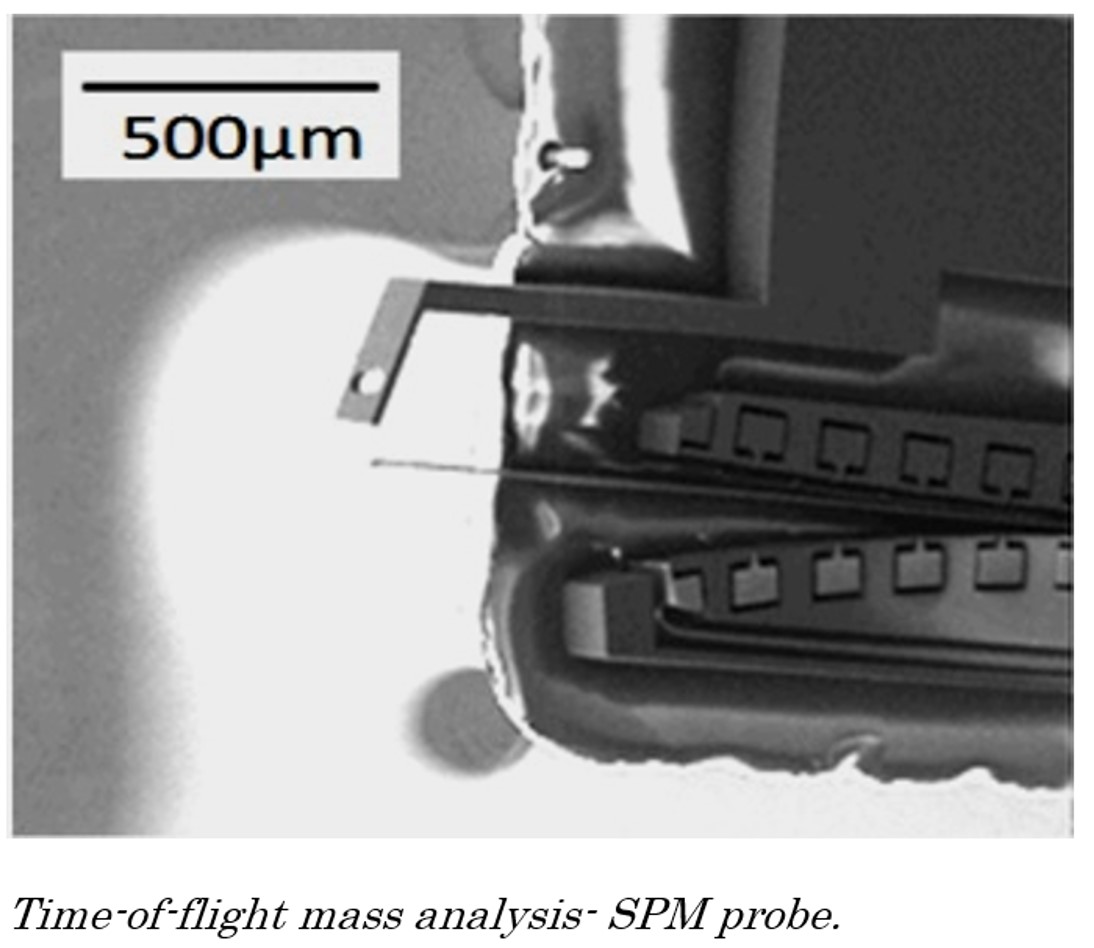
Scanning Probe Microscopy (SPM) families have been widely used as an essential tool in nanoscience, with applications
in an increasing range of fields such as nanomaterials, bioscience and nanoengineering. Also the environment required for
dynamic SPM is broadening, allowing applications as nanolithography, nano-oxidation, controlled deposition of molecules,
fabrication of nanotransistors and molecular modification. Up to now, we have developed various microprobe technologies
including probes for SPM, near-field microscopy, nanolithography and data storage. Figure shown below is a time-of-flight (TOF)
mass analysis-SPM probe, which can handle atom or molecule on surface and analyze it mass using the TOF-mass SPM.
The atoms picked up from surface can be emitted toward TOF-mass using the ring-shaped extra-electrode placed near the probe.
The modes for surface observation and mass analysis can be switched by the electrostatic actuator.
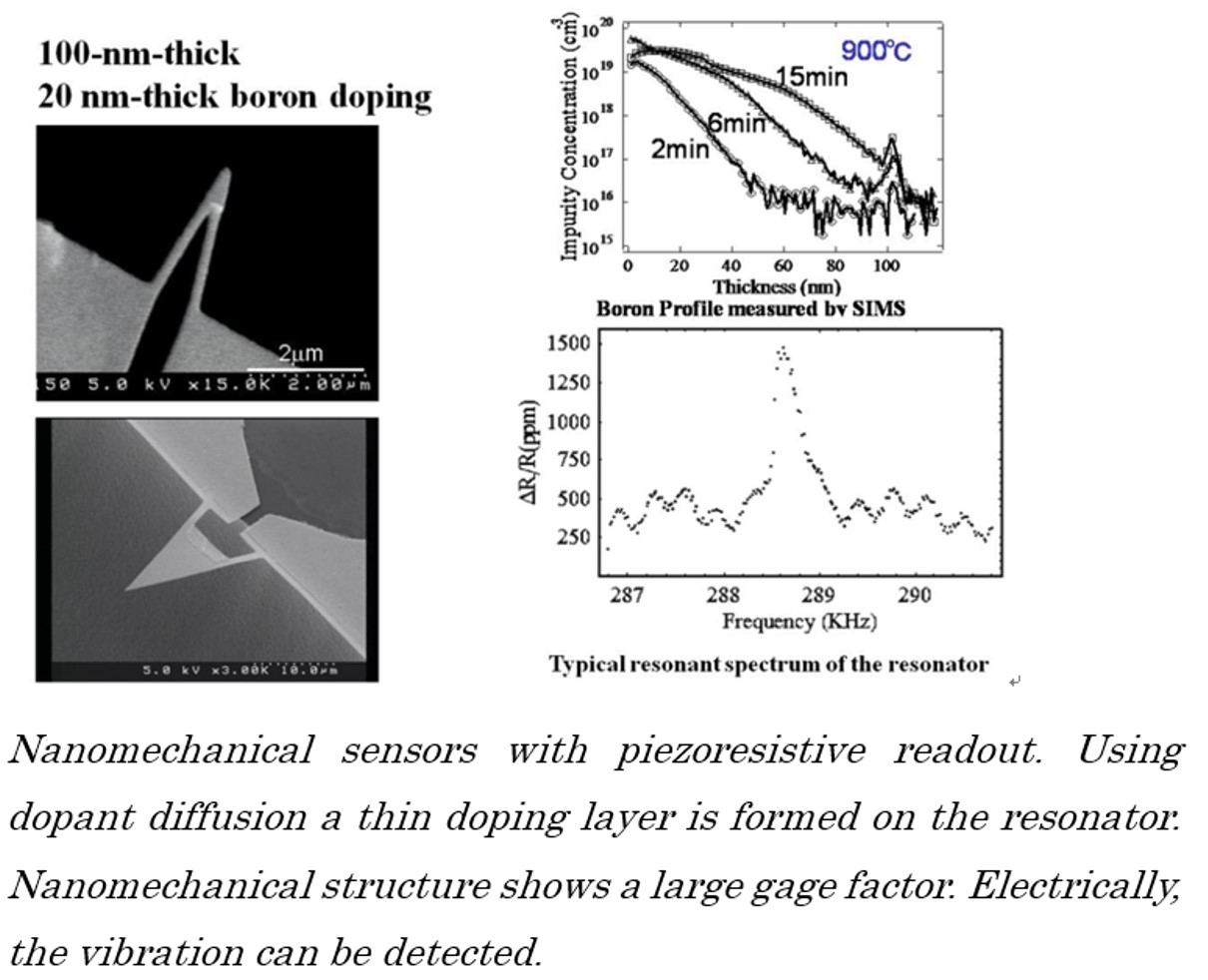
Researches on the nanomechanics of resonators and its applications have been conducted.
High Q resonator can store the vibration energy from weak periodic physical interaction to the resonator,
thus, high sensitivity to force, mass and heat etc. can be achieved. The minimum detectable value is limited by
thermomechanical noise, which can be reduced by increasing the Q factor. Generally, surface defects and contaminants
on the resonator significantly increase the vibration energy losses, which reduce the Q factor. We are working on the method
to increase the Q factors by material selection, surface treatment and thermal annealing. Also as an application of the resonators,
we are working on mass sensors, chemical sensors, force sensors, magnetic sensors and thermal sensors.
Nanomechanical resonators often exhibit mechanical non-linearity, where the resonant frequency changes as increasing the
vibration amplitude (Hard and soft spring effects). We found that the nanomechanical resonator shows strong non-linearity, which
depends on the size and surface state. Using this non-linearity, novel applications will be developed for sensors, such as stochastic
resonance and mechanical coupling for frequency conversion. Also a nonlinear damping effect, where the Q factor depends on the vibration
amplitude, is investigated.
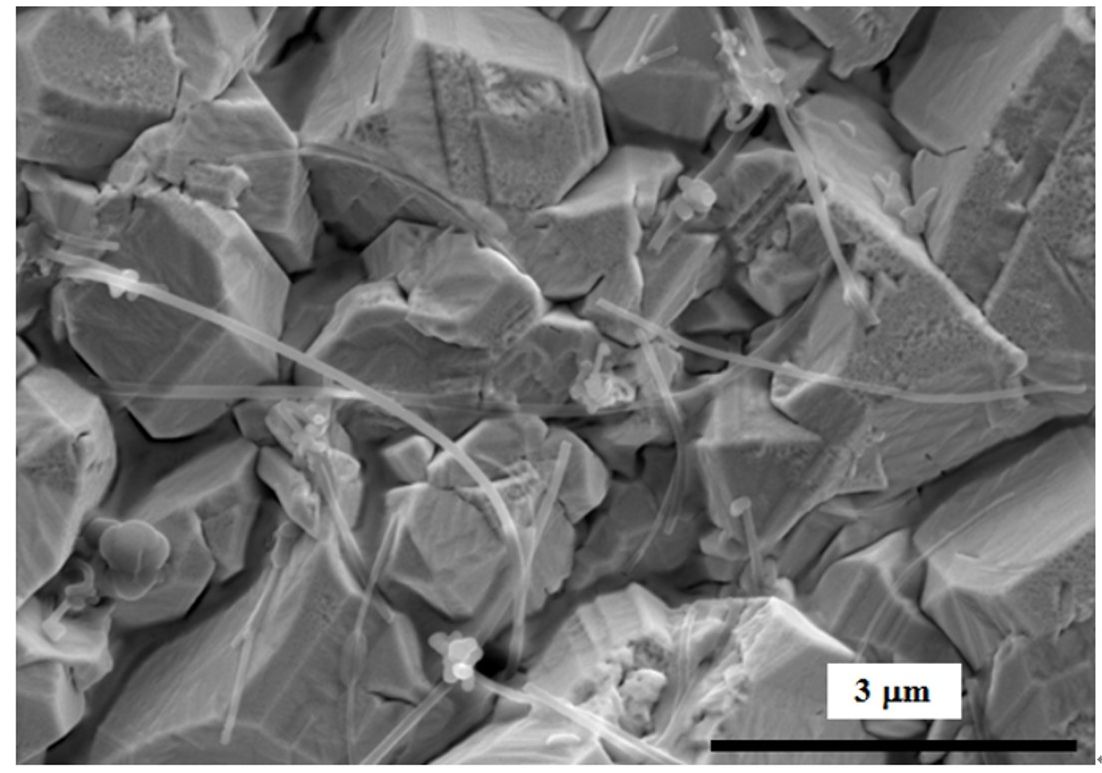
Various nanomaterials and their deposition methods have been studied for applications to sensors and micro/nanosystem in future.
Selective growth techniques of carbon nanotubes and graphenes, electrodeposition technologies of nanocomposites, and growth of
nanodiamond have been conducted. In addition, 2D material growth and application to nanomechanics are our interest.
A lot of energy is emitted as exhaust heat from instruments and equipment, and the importance of the
energy recovery increases for saving energy, where thermal every to electric energy conversion are key technology.
Also small and high efficiency thermoelectric power generators are required for body area network. Laboratory is working on
various thermal energy power generation including thermoelectric and thermo electron (Thermionic) power generation.
Thermionic power generator utilize phenomenon of thermionic electron emission. A heated metal or semiconductor (emitter)
emits electrons at high temperatures, and the electron can be collected by a collector electrode. This is direct conversion
from thermal energy to electric energy, but generally it operates at very high temperature > 1500?C.
We have developed novel micro thermionic power generator with narrow gap between the emitter and the collector.
Also we are working on flexible thermoelectric power generators and deposition method of thermoelectric materials for body area network.
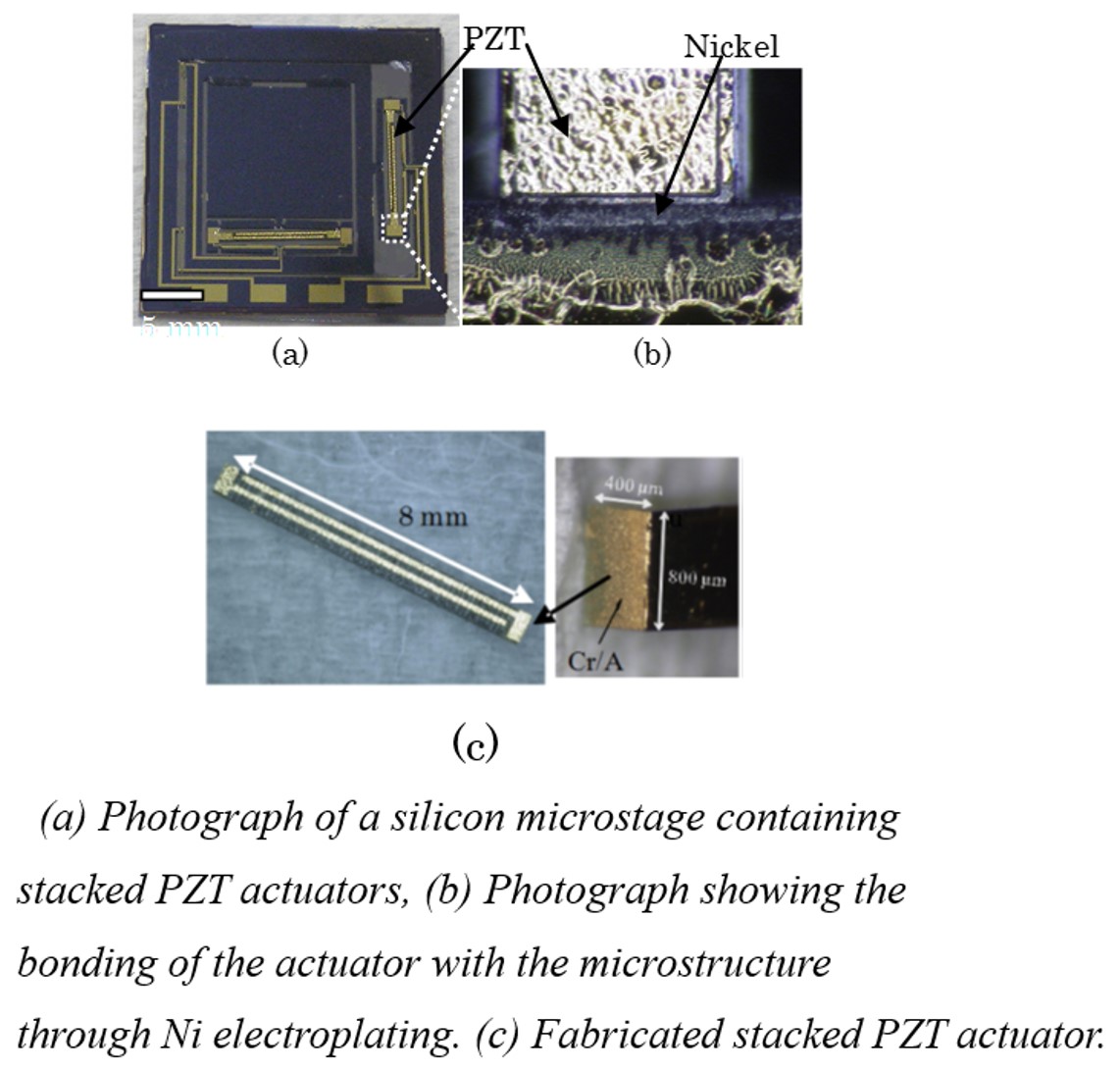
We develop a microstage that is able to produce a large displacement, high accuracy, a large stage area and high resonant frequency with
low cost for positioning devices for scanning probe and miniature data storage systems. A displacement enlargement micromechanism is integrated in the stage.
The microstage is made from a 400-Êm-thick silicon substrate with a 200-nm-thick SiO2 layer. A metal electrode pattern is formed on it. The pattern and shape of the microstage were formed
using photolithography and deep reactive ion etching processes.
The stacked PZT actuator was fabricated from an N-10 (NEC/Tokin co.ltd) type 1-mm-thick PZT plate. 600 Êm deep grooves with a pitch of
130 Êm were produced using a 20 Êm-thick dicing blade. Ni electrodes were then formed in the grooves using the electroplating process.
After polishing both sides of the plate, polyimide was coated on the top side as an insulator. Next, electrical circuitry was formed by the photolithography.
Figure(c) shows the fabricated stacked actuator.
The PZT actuators are then slotted accurately into this well structure. Then, using pulsed electroplating of Ni, the PZT actuators are fixed by electroplating.
Prior to the electroplating, thick photoresist was coated and patterned on the XY microstage structure. In addition, metal as a seed layer for electroplating is deposited.
Figure shows the fabricated microstage containing the stacked PZT actuator. Ni was grown selectively at the locations where the seed metal became exposed.
Actuation of the microstage are demonstrated. At applying voltage of 50 V, 20 Êm of displacement is demonstrated. Also an XYZ microstage has been developed using a micro-assembly process.







